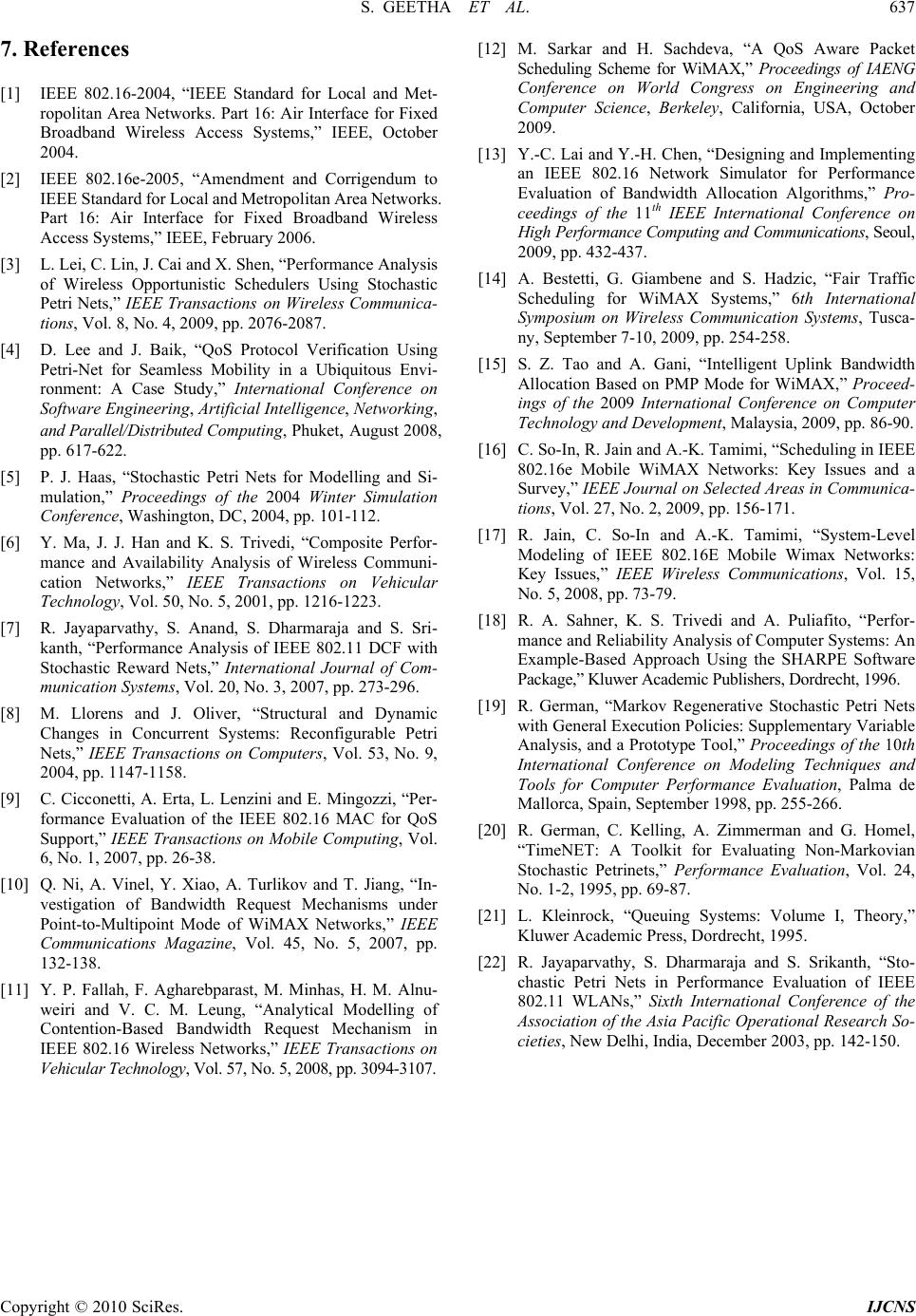
S. GEETHA ET AL.
Copyright © 2010 SciRes. IJCNS
7. References
[1] IEEE 802.16-2004, “IEEE Standard for Local and Met-
ropolitan Area Networks. Part 16: Air Interface for Fixed
Broadband Wireless Access Systems,” IEEE, October
2004.
[2] IEEE 802.16e-2005, “Amendment and Corrigendum to
IEEE Standard for Local and Metropolitan Area Networks.
Part 16: Air Interface for Fixed Broadband Wireless
Access Systems,” IEEE, February 2006.
[3] L. Lei, C. Lin, J. Cai and X. Shen, “Performance Analysis
of Wireless Opportunistic Schedulers Using Stochastic
Petri Nets,” IEEE Transactions on Wireless Communica-
tions, Vol. 8, No. 4, 2009, pp. 2076-2087.
[4] D. Lee and J. Baik, “QoS Protocol Verification Using
Petri-Net for Seamless Mobility in a Ubiquitous Envi-
ronment: A Case Study,” International Conference on
Software Engineering, Artificial Intelligence, Networking,
and Parallel/Distributed Computing, Phuket, August 2008,
pp. 617-622.
[5] P. J. Haas, “Stochastic Petri Nets for Modelling and Si-
mulation,” Proceedings of the 2004 Winter Simulation
Conference, Washington, DC, 2004, pp. 101-112.
[6] Y. Ma, J. J. Han and K. S. Trivedi, “Composite Perfor-
mance and Availability Analysis of Wireless Communi-
cation Networks,” IEEE Transactions on Vehicular
Technology, Vol. 50, No. 5, 2001, pp. 1216-1223.
[7] R. Jayaparvathy, S. Anand, S. Dharmaraja and S. Sri-
kanth, “Performance Analysis of IEEE 802.11 DCF with
Stochastic Reward Nets,” International Journal of Com-
munication Systems, Vol. 20, No. 3, 2007, pp. 273-296.
[8] M. Llorens and J. Oliver, “Structural and Dynamic
Changes in Concurrent Systems: Reconfigurable Petri
Nets,” IEEE Transactions on Computers, Vol. 53, No. 9,
2004, pp. 1147-1158.
[9] C. Cicconetti, A. Erta, L. Lenzini and E. Mingozzi, “Per-
formance Evaluation of the IEEE 802.16 MAC for QoS
Support,” IEEE Transactions on Mobile Computing, Vol.
6, No. 1, 2007, pp. 26-38.
[10] Q. Ni, A. Vinel, Y. Xiao, A. Turlikov and T. Jiang, “In-
vestigation of Bandwidth Request Mechanisms under
Point-to-Multipoint Mode of WiMAX Networks,” IEEE
Communications Magazine, Vol. 45, No. 5, 2007, pp.
132-138.
[11] Y. P. Fallah, F. Agharebparast, M. Minhas, H. M. Alnu-
weiri and V. C. M. Leung, “Analytical Modelling of
Contention-Based Bandwidth Request Mechanism in
IEEE 802.16 Wireless Networks,” IEEE Transactions on
Vehicular Technology, Vol. 57, No. 5, 2008, pp. 3094-3107.
[12] M. Sarkar and H. Sachdeva, “A QoS Aware Packet
Scheduling Scheme for WiMAX,” Proceedings of IAENG
Conference on World Congress on Engineering and
Computer Science, Berkeley, California, USA, October
2009.
[13] Y.-C. Lai and Y.-H. Chen, “Designing and Implementing
an IEEE 802.16 Network Simulator for Performance
Evaluation of Bandwidth Allocation Algorithms,” Pro-
ceedings of the 11th IEEE International Conference on
High Performance Computing and Communications, Seoul,
2009, pp. 432-437.
[14] A. Bestetti, G. Giambene and S. Hadzic, “Fair Traffic
Scheduling for WiMAX Systems,” 6th International
Symposium on Wireless Communication Systems, Tusca-
ny, September 7-10, 2009, pp. 254-258.
[15] S. Z. Tao and A. Gani, “Intelligent Uplink Bandwidth
Allocation Based on PMP Mode for WiMAX,” Proceed-
ings of the 2009 International Conference on Computer
Technology and Development, Malay s ia , 2009, pp. 86-90.
[16] C. So-In, R. Jain and A. -K. Tamimi, “Scheduling in IEEE
802.16e Mobile WiMAX Networks: Key Issues and a
Survey,” IEEE Journal on Selected Areas in Communica-
tions, Vol. 27, No. 2, 2009, pp. 156-171.
[17] R. Jai n, C. So-In and A.-K. Tamimi, “System-Level
Modeling of IEEE 802.16E Mobile Wimax Networks:
Key Issues,” IEEE Wireless Communications, Vol. 15,
No. 5, 2008, pp. 73-79.
[18] R. A. Sahner, K. S. Trivedi and A. Puliafito, “Perfor-
mance and Reliability Analysis of Computer Systems: An
Example-Based Approach Using the SHARPE Software
Package,” Kluwer Academic Publishers, Dordrecht, 1996.
[19] R. German, “Markov Regenerative Stochastic Petri Nets
with General Execution Policies: Supplementary Variable
Analysis, and a Prototype Tool,” Proceedings of the 10th
International Conference on Modeling Techniques and
Tools for Computer Performance Evaluation, Palma de
Mallorca, Spain, September 1998, pp. 255-266.
[20] R. German, C. Kelling, A. Zimmerman and G. Homel,
“TimeNET: A Toolkit for Evaluating Non-Markovian
Stochastic Petrinets,” Performance Evaluation, Vol. 24,
No. 1-2, 1995, pp. 69-87.
[21] L. Kleinrock, “Queuing Systems: Volume I, Theory,”
Kluwer Academic Press, Dordrecht, 1995.
[22] R. Jayaparvathy, S. Dharmaraja and S. Srikanth, “Sto-
chastic Petri Nets in Performance Evaluation of IEEE
802.11 WLANs,” Sixth International Conference of the
Association of the Asia Pacific Operational Research So-
cieties, New Delhi, India, December 2003, pp. 142-150.